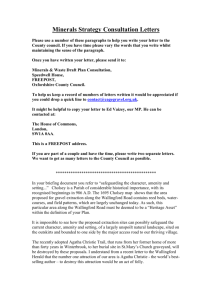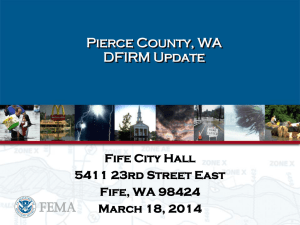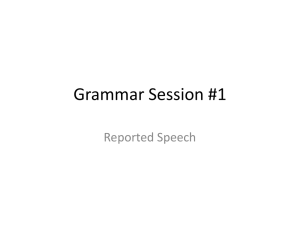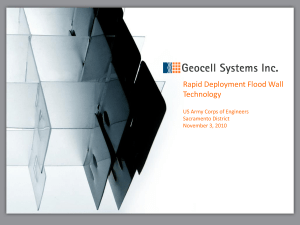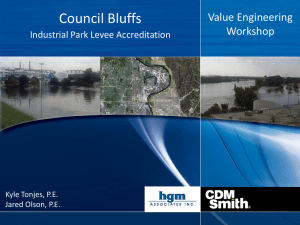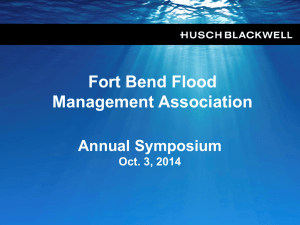ILH approach to levee failure mechanisms
advertisement
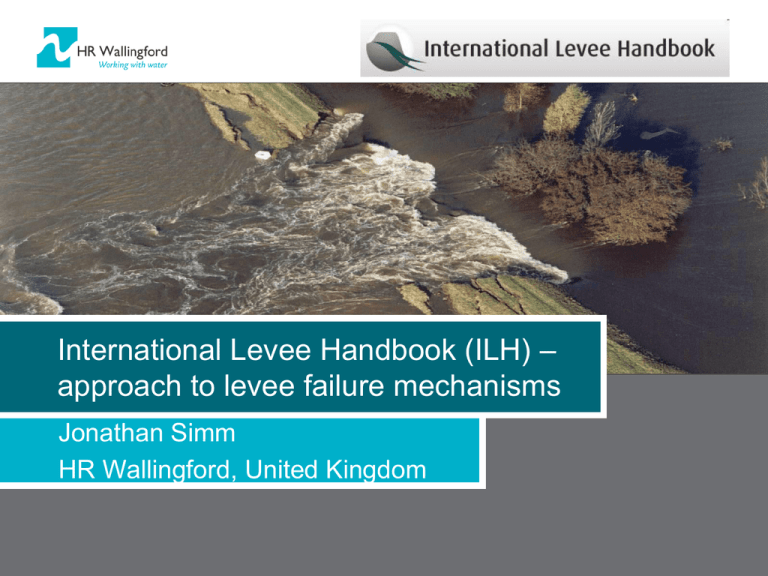
International Levee Handbook (ILH) – approach to levee failure mechanisms Jonathan Simm HR Wallingford, United Kingdom Presentation summary 1. Motivation and drivers for ILH 2. Understanding ‘Failure’ Structure of International Levee Handbook (ILH) 3. ILH approach to failure mechanisms Page 2 © HR Wallingford 2012 Handbook motivation > Recent international levee failures during severe flooding events causing loss of life and severe property damage: Katrina (2005) Xynthia (2010) - Atlantic coast of France Summer 2007 fluvial floods UK > Address poor understanding and interface between geotechnics and H&H communities of practice in levee design and management > Desire to produce best practice handbook for owners, operators, designers & constructors. Page 3 © HR Wallingford 2012 ILH structure Page 4 © HR Wallingford 2012 Failures and levee management life cycle > Levee deterioration and damage in routine levee management (O&M, assessments) > Managing damage and breach before, during and after severe events > Allowing for external change (loadings, land-use) and effect on probability or consequence of failure Page 5 © HR Wallingford 2012 Failure frequency/probability > UK probabilistic flood systems analysis uses a frequency-based approach to levee failure (fragility curves). > This allows back-attribution of the residual risk in the flood plain to levee segments. Standard of protection provided by defence Probability of defence failure Difference relates to factor of safety in design 1.0 Typically assumed fragility curve ‘True’ fragility 0 0 Severity of load event Page 6 © HR Wallingford 2012 Levee fragility and deterioration of asset state HLM+ Fragility curve - Condition Grades 1 to 5 (Central estimates) 1.0 P (breaching¦feeboard) 0.9 0.8 0.7 Condition grade1 Condition grade2 Condition grade 3 Condition grade4 Condition grade 5 0.6 0.5 Structure 0.4 Deterioration0.3 0.2 0.1 0.0 -1.5 -1.0 -0.5 0.0 0.5 1.5 1.0 Overflow head (Water level - crest level) Page 7 © HR Wallingford 2012 Progressive vs sudden mechanisms Physical State of a levee segment Deterioration threshold (SLS) Progressive State of a levee segment Deterioration Sudden Break Damage (ULS) Damage (ULS) Load Time (or Loading or other) (For instance: external/internal erosion mechanism) (For instance: sliding mechanism) Functional Function performance Progressive Function performance Degradation Degradation threshold (SLS) Failure threshold (ULS) Sudden Break Failure threshold (ULS) Time or Loading or other Load Page 8 © HR Wallingford 2012 Physical vs functional failure PHYSICAL FUNCTIONAL 1, n 1, n Component(s) Function(s) Deterioration Degradation Damage Functional failure Mechanism(s) Functional analysis Granularity Level 1 System failure Granularity Level 2 Hydraulic failure Granularity Level 3 Structural failure Type of failure Physical Not applicable at granularity 1 Functional Functional failure of protection Inundation not prevented by levee Segment technical inability/ruin e.g. gate, breach cannot be closed Damage to a levee cross section. e.g. loss of water-side clay cover Hydraulic functional failure. e.g. unexpected inundation occurs over/through the levee segment Structural functional failure e.g. failure of the impermeability function Page 9 © HR Wallingford 2012 Definitions (and difficulties) Types of structural mechanism scenarios > Deterioration – Generally slow process by which resilience or standard of protection is reduced. Deterioration is best managed by good maintenance. > Damage – Rapid deterioration such as scour and slippage (commonly during a flood) that does not cause a breach but which requires immediate repair or emergency action. > Breach – Catastrophic collapse (often at high water level). Results in significant loss of crest and causes substantial loss of water. Time and causation chains are significant in distinguishing between the above. Hydraulic performance mechanisms > Performance Failure – Overtopping or through-flow at an hydraulic elevation or load below the design standard which does not cause damage or breach Page 10 © HR Wallingford 2012 Scenarios of mechanisms Breach Key Loss of crest Animal borrowing Overtopping Erosion Event AND Gate OR Gate Lack of resistance to surface erosion Overtopping Lack of scour protection Local overtopping Extreme high water level Local Settlement Consolidation of foundation soils Compaction of fill materials Internal erosion of fill or foundation soil Desiccation cracking Loose noncohesive soils Animal borrowing Deterioration Overtopping Erosion Damage BREACH Breach Poor vegetation control High water level Animal borrowing Trafficking by animals or humans High water level External Event Overtopping Local Event Page 11 © HR Wallingford 2012 Explaining mechanisms > Explanations of individual physical mechanisms (Chapter 3) > Deterioration/damage mechanism categories: Internal erosion External erosion Mass instability > Descriptions of mechanisms help the levee assessment process (Chapter 5) Page 12 © HR Wallingford 2012 Failure modes: transitions and embedments Page 13 © HR Wallingford 2012 Overtopping (may be functional failure) > Chapter 2 describes flood risk management context of levees and setting of functional requirements > Chapter 8 gives methods for calculating overflow/overtopping > Chapter 6 describes emergency management of overflow/overtopping Page 14 © HR Wallingford 2012 Deterioration > Chapter 4 describes inspections and routine repairs required for various deterioration and damage mechanisms > Chapter 5 Describes assessment of levee state. > Chapter 9 describes design of engineered improvement or repair measures Page 15 © HR Wallingford 2012 Damage > Chapter 3 describes different damage mechanisms > Chapter 8 gives tools for analysing different mechanisms (limit state equations) > Chapters 9 and 10 describe potential failures than can arise during construction and how to avoid them Page 16 © HR Wallingford 2012 Breach > Chapter 8 gives tools for assessing breach dimensions and inundation hydrographs > Chapter 6 discusses managing breaches and temporary repairs Page 17 © HR Wallingford 2012 Summary > The issue of failure mechanisms has been identified as an important practical theme for the International Levee Handbook (ILH). > The ILH team differentiates between: Performance failure (water passage below design standard). Deterioration (slow reduction in condition of levee) Damage (physical damage requiring immediate repair) Breach (collapse followed by uncontrolled loss of water). > These are associated with interacting hydraulic processes (overflow, overtopping, seepage) and geotechnical processes (internal erosion, external erosion and mass instability) > The ILH describes how to identify and manage and design for these mechanisms and scenarios Page 18 © HR Wallingford 2012 > Draft for review by September 2012 > Technical work complete March 2013 > Editing / printing complete September 2013 > Will be available as hard copy and pdf Questions? See also www.leveehandbook.net HR Wallingford Howbery Park, Wallingford, Oxfordshire OX10 8BA, United Kingdom tel +44 (0)1491 835381 fax +44 (0)1491 832233 email info@hrwallingford.com

